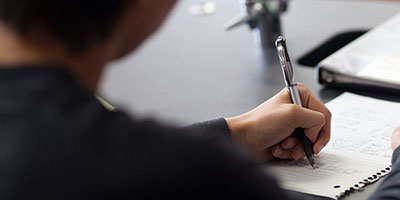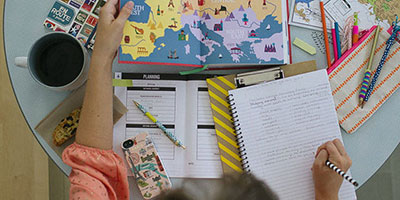Faculty and Staff
Reflection in Practice
Finding value in reflection
The regular practice of critical reflection cultivates a habit of self-examination of past experiences. Its goal is self-knowledge, challenging our past practices, thoughts, and assumptions; and informing our current and future beliefs, actions, and self-understanding.
The basic process of reflection follows the ERA model – Experience, Reflection, Action. Most reflective models have a similar underlying structure. One of the biggest values of reflection comes when we repeat the reflective process again and again for a series of experiences. Following an experience, we reflect on it and identify learning and actions that feed into future experiences, increasing the learning and value each time we go through the reflective process.
By building an ongoing process of reflection, we create significant additional value, including:
- Strengthening our reflective skills and habits
- Producing deeper reflections that enhance learning and self-awareness
Reflection Models/Frameworks
5R’s — (Bain et al., 2002)
- Reporting of the context of the experience
- Responding to the experience (observations, feelings, thoughts, etc.)
- Relating the experience to knowledge and skills you already have
- Reasoning about the significant factors/theory to explain the experience
- Reconstructing your practice by planning future actions for a similar experience
Gibb’s — (Gibbs, 1988)
- Description of the experience
- Feelings and thoughts about the experience
- Evaluation of the experience, both good and bad
- Analysis to make sense of the situation
- Conclusion about what you learned and what you could have done differently
- Action plan for how you would deal with similar situations in the future, or general changes you might find appropriate
Four F’s — (Greenaway et al., 2015)
- Facts: An objective account of what happened
- Feelings: The emotional reactions to the situation
- Findings: The concrete learning that you can take away from the situation
- Future: Structuring your learning such that you can use it in the future
CARL — (University of Edinburgh, 2018)
- Context: Briefly describe the context of you experience
- Action: Explain what actions you took
- Results: Explain what happened as a result of your actions
- Learning: Identify what you have learned
What? So what? Now what? — (Driscoll, 1994; Borton, 1970)
- ‘Now what?’ allows you to create an action plan for the future based on the previous questions.
- ‘What?’ helps you describe the situation you want to learn from. You should identify the facts and feelings of the situation.
- ‘So What?’ allows you to extract the meaning of ‘What?’. Moreover, you should question what knowledge you and others had in the situation, and what knowledge or theories that could help you make sense of the situation.
Assessment
Assignments/Activities
Summative
- A reflective journal
- A report that pulls on evidence from a reflective journal
- A reflective blog
- A reflective essay on the student’s development in the course
- A reflective essay on meeting benchmark statements
- A reflective essay on a particular experience (for example a critical incident in an experiential learning course)
- A skills-development log
Formative
- Individual entries from a reflective journal
- A reflective blogpost
- Interim essays on development during the course or on benchmark statements
- Drafts on reflective summative assessments
- Reflective workbooks
Criteria
(Question to ask yourself while developing assessment criteria for assignments)
- Why am I asking students to reflect (what do I hope they gain from it)?
- How does this assignment/activity relate to my learning outcomes?
- Is there clear alignment between this assignment/activity and the course’s learning outcomes?
- What does doing well on this assignment/activity look like?
- What will not be sufficient to pass?
- What questions/aspects must be addressed for this work to be acceptable?
- What are the different dimensions that make up the assignment/activity? (For example clarity, critical thinking, evidence, etc.)
(And what does ‘good’ reflection look like?)
- What do I think good reflection looks like?
- What will students need to demonstrate in the reflective task to make it helpful for achieving my learning outcomes?
- To what extent do I want students’ reflections to be similar to my idea of good reflection? Is it enough they just reflect?
Rubrics (Holistic and Analytical)
Holistic rubric: Gives general description of different performance levels (e.g., novice, apprentice, proficient, or distinguished)
Reflective writing rubric example developed by Chabon and Lee-Wilkerson (2006) when evaluating reflective journals of students undertaking a graduate degree in communication sciences and disorders.
- Level 1 (Descriptive): Students demonstrate acquisition of new content from significant learning experiences. Journal entry provides evidence of gaining knowledge, making sense of new experiences, or making linkages between old and new information.
- Level 2 (Emphatic): Students demonstrate thoughts about or challenges to beliefs, values, and attitudes of self and others. Journal entry provides examples of self-projection into the experiences of other, sensitivity towards the values and beliefs of others, and/or tolerance for differences.
- Level 3 (Analytic): Students demonstrate the application of learning to a broader context of personal and professional life. Journal entry provides evidence of student’s use of readings, observations, and discussions to examine, appraise, compare, contrast, plan for new actions or response, or propose remedies to use in and outside structured learning experiences.
Level 4: Students demonstrate examination of the learning process, showing what learning occurred, how learning occurred, and how newly acquired knowledge or learning altered existing knowledge. Journal entry provides examples of evaluation or revision of real and fictitious interactions.
Analytical rubric: Allows for identification of performance against defined assessment criteria (e.g., Analysis, Presence, Description)
This page was adapted from University of Edinburgh Reflection Toolkit with permission.
Dr. Jennifer Van Reet
Director of the Center for Engaged Learning
Professor of Psychology
Library 211
401.865.1824
jvanreet@providence.edu
Dr. Darra Mulderry
Associate Director of the Center for Engaged Learning
Director, National and International Fellowships
Library 212
401.865.1745
Amy Goggin
Assistant Director of the Center for Engaged Learning
Library 212
401.865.1834
agoggin@providence.edu









